Call Us
+91 9326762293Email Us
contact@chakrayog.comCall Us
+91 9326762293Email Us
contact@chakrayog.com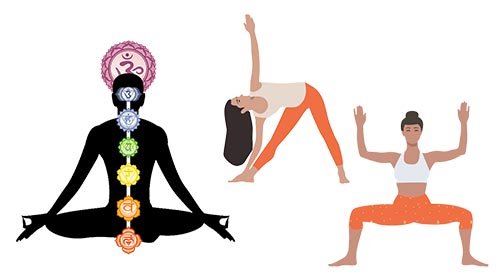
The life force energy (known as “prana”) passes through the subtle body through a number of channels known as “nadis” in yoga. These nadis meet at areas of amplified energy known as “chakras.” Chakras are swirling vortexes of energy in the subtle body that correlate to specific glands along the spine and within the head. They are named after the Sanskrit word for “wheel.” When the nadis get blocked due to bad behaviors and old patterns, the chakras become stagnant. The life force becomes sluggish as a result, which may lead to reduced physical, mental, and emotional health. Yoga practice cleanses and revitalizes the nadis and chakras, allowing prana to flow freely again.
Yoga is an incredibly useful method for releasing prana, or life energy, when it becomes wedged. Through yoga poses (asanas) and breathing, yoga dissolves musty energy and allows new energy into our chakra system. As a means of rebalancing our chakras so that they work optimally we may practice yoga as it definitely helps to either activate a blocked chakra or discharge excess energy from a dysfunctional chakra, for example when a chakra becomes overactive.
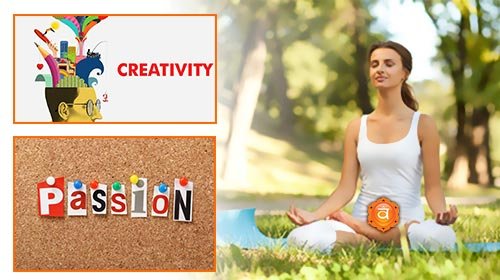
An effective way to bring to balance the Sacral (Swadhisthana) Chakra is to resort to yoga asanas practice on a regular basis, which stabilizes and balances your physical body’s energies from the sacral vortex. Makes it simpler to break old habits and patterns by realigning Swadhisthana, which is the center of emotional patterns and behaviors we adopt when being with others. Located in the lower abdomen amid the navel and genitals, this is the seat of the self from where we crave our earthly destiny. This chakra is related with creativity, expression, passion, emotional wellbeing and sensitivity, fearlessness, joyful experiences, pleasure, taste, sensuality, and sexual energy, which sum totals to the unique identity that you are born with. Yoga exercises involving the part of the body of this chakra are aimed to dissolve any blockage at this energetic level.
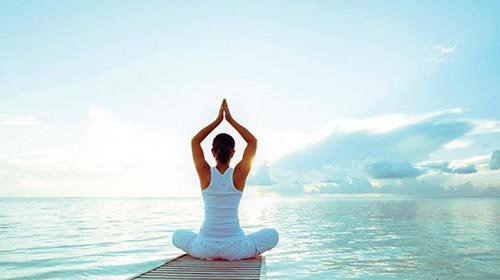
Yoga can be practiced at home, in natural environments or in a yoga studio. At the same time, each chakra is connected with different universal elements being Air, Earth, Water, Ether or Fire. While yoga asanas may be practiced with beneficial results in many distinct surroundings, it is recommended whenever is possible to do these in particular places related to the chakra’s element to enhance the whole experience and results. In the case of Swadhisthana as it is connected with the flow of our emotions, yoga practiced outdoors in contact or surrounded by the water element is the first choice to heighten the healing experience of the practice. When this is not doable to perform, we can equally get beneficial results by practicing it at our home, yoga studio or other specifically dedicated space for this practice too.
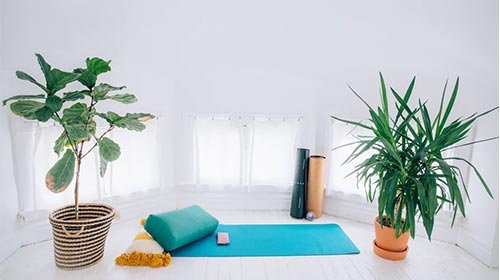
Creating a home yoga studio has several advantages and may take your yoga practice to a whole new and enhanced level. It helps you to immerse yourself in yoga so that it becomes a more important part of your everyday rather than something that is exclusively performed at a studio. Indeed, yoga experts and teachers acclaim contrary to popular belief to practice yoga at your own pace in your own place rather than in busy and distracting public yoga centers which tend to rush the practice in too active modes and with limited time and procedures. They reiterate that the practice of yoga should be paced at each person’s rhythm thus allowing a much better integration of the practice as it involves aspects like focus, absorption, breathing or meditation. Therefore, getting involved in public spaces with yoga experienced teachers is principally suggested mostly to get started with the right postures under their supervision at first, but more personal places and environments are more suitable for yoga practice for the healing and balancing of our energy centers (chakras) in the long-term.
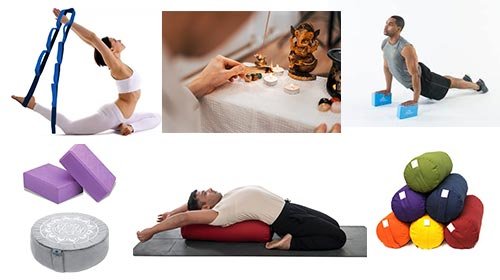
Even in the tiniest of areas, you can carve out a nook and corner for your home yoga studio. The first item you’ll need is a yoga mat, or if you can’t find one, a towel will do. It will protect you from slipping and sliding while you practice yoga.
Below are some other items you may need in your daily yoga practice:

As you work with this chakra, opening your hips and forward-folding practice unleash creativity as you cultivate flexibility in your pelvis. In order to do this, you can use hip openers and forward folds, build a sensation of fluidity and ease there in your low belly, low back, hips, sacral plexus, and pelvis.
Creative movement is one method to tap into the power that exists within this chakra. You are born with creative movement; all you have to do is remind yourself of it. And by doing so, you will also be able to access creative thinking.
Creative thinking gives you the ability to take constructive actions that may affect your life and the lives of others.
Swadhisthana (“seat-of-self”), is the second stage after Muladhara, once we have found stability and structure now is the moment to enjoy our life, ourselves, our relationships and our flowering interaction with the world. Both chakras are linked to our pelvic floor area which is very important to keep healthy not only for its function of sustenance for the body but also for making possible its movements. When we have a balanced Swadhisthana chakra, we feel joyful and respond to others reflecting a positive light, no matter what life throws at us.

Take a seat and take a minute to establish your purpose for this exercise. Here are some topics related to this chakra to lubricate the wheels: Unlocking creativity; going with the flow; letting go of old emotional stories; releasing grief, fear or rage that is trapped in your cell tissue; allowing joy and happiness into your life; letting go of compulsions; healing emotional bonds; understanding and fostering healthy boundaries; merging into the stream of something larger than yourself. Once you choose an intention practice this pose for min. 20 mins.

Stand in a wide straddle, feet approximately 4 feet apart, facing the long edge of the mat. Turn your right foot and leg out so that they face toward the mat’s short edge. Knees slightly bent to a maximum of 90 degrees. Raise your arms horizontally over your legs. Stretch your spine from tail to crown, moving your shoulder blades along the ribs. Soften the texture of your skin inward while you stand in the Warrior posture, and let it to remind you of your inherent receptive nature. You are a creative, powerful, and lovely creature who is neither aggressive nor passive. Spend 5 breaths here, seeing them as rivers of light coursing through your complete bodily, emotional, and mental selves. Repeat several times.

As you side bend over the rear leg in Warrior II, put your left hand to your left thigh. Maintain your front ribs, zip up your low belly, and extend the right-side waist without compressing the left. Press down it through feet and raise up through the low belly. Allow your unique self to transform this shape into a large and unfettered manifestation of your flowing creative ability. Take 5 deep breathes here. As you side bend over the rear leg in Warrior II, put your left hand to your left thigh. Maintain your front ribs, zip up your low belly, and extend the right-side waist without contracting the left. Press down through the feet and raise up through the low belly. Allow your creative self to transform this shape into a large and unfettered manifestation of your flowing creative ability. Take 5 deep breathes here. Repeat several times.
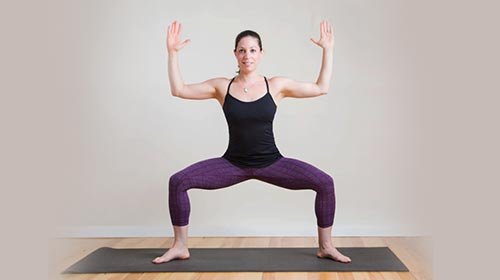
Straddle your legs, extend your feet and legs, and bend your knees. The knees should be above the heels rather than beyond them. Squeeze the thighbones back and the sit bones forward. Find your equilibrium and ground your feet. Now, start moving in whatever manner that feels good to you! You may bounce your pelvis softly up and down and move your arms in whatever creative manner you like. Get in touch with your inner beat. Try staying in this stance for a bit longer and you’ll see that it’s actually simpler to move in this pose than it is to stay motionless. In reality, the pelvis loves to move, and a healthy energy flow in the sacral area can substantially improve your low back and hips. Move here to engage with the water element and your free-flowing imaginative creativity. Keep going for 5–10 breaths, or as long as you can without effort. Repeat again.
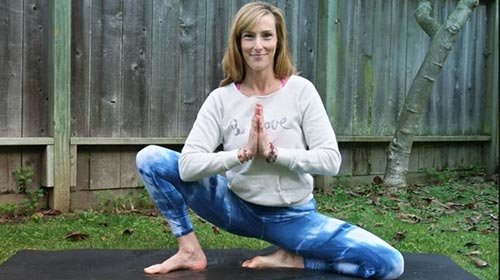
Step your right foot through your hands and gently lay your left knee on the floor from Downward-Facing Dog (Adho Mukha Svanasana). Turn to the left side while maintaining your right foot in which it is. Sit on your left foot, with your left knee pointing toward the rear end of your mat. If this is not possible, you can alter by standing on a block. Bring your hands to your heart in the Anjali Mudra. Actively spread the legs off and lower the tailbone down. Feel the lower spine extend as you press into the feet. Spend 5 breaths in this thorough hip opening. Take a vinyasa or continue to Downward-Facing Dog and swap sides. Repeat again.
Restorative yoga poses are practiced always at the end of the yoga practice to provide rest to the body and self-assimilation of the yoga asanas previously done. They are all about slowing down and incorporating what has been done.

Bend your left knee and bring it to your left wrist from hands and knees, resting your outer skin and thigh down on the mat. Stretch your left leg straight behind you. Align your hips to the front edge of the mat and lie your belly, chest, and head down. Come out of the position if you feel any pain in your knees. Intentionally release your belly as you start to soften. Let any abdominal tightness go—let it all hang out. Allow your eyes and jaw to totally relax as you exhale deeply. Spend 5–7 calm, deep breaths here. Coming out of the posture slowly, you may do a vinyasa or transition into Downward-Facing Dog to switch sides.

Bend the knees and pull the soles of the feet together when the legs extend out and down toward the ground from a sitting straight-legged stance (Dandasana). The heels should be aligned squarely in front of the pubic bone. Fold forward, bringing your belly, chest, and head closer to the ground. Keep the legs moving and the heart aside from the belly. You can fold forward as far as you like as long as your knees don’t hurt. Close your eyes and focus on your low tummy, low back, and lower pelvis. Take five deep breaths here. Imagine that whatever emotional baggage you’re ready to let go of is trickling down and out via the pelvic floor with each breath. Reclaim this gap as creative possibility for going ahead with each breath. Take your time getting out of the fold. Hold on the pose.
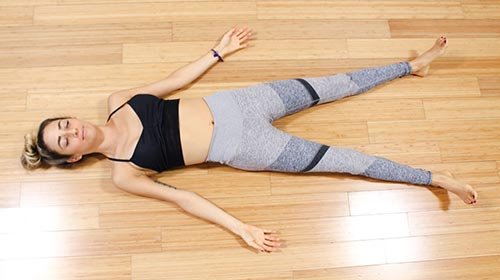
When you’re finished, fall back in Savasana and allow your body to relax as if you’re floating on top of water, drifting into a tranquil and pleasant repose.
Aside from the yoga positions outlined above, cultivating a deeper feeling of steadiness throughout your practice may take various forms. If visualizations have previously benefited you in your practice, consider imagining or wearing the color orange, which is the color of the Sacral (Swadhisthana) Chakra. This vision may assist you in reconnecting with your inner child revealing a stronger connection while practicing the above yoga asanas. Singing mantras and also using sound vibrations in the background is another excellent approach to connect with your Sacral (Swadhisthana) Chakra while doing yoga.
No products in the cart.

Tripura Universal Healing Malaysia
Tel : 0169067380
Dr. A. Kumaran is the founder of Malaysia Sri Bala Tripurasundari Peedam residing in Sri Saradha Devi Ashram Rawang. The young spiritualist Professionak is a Grand Reiki Master, trained in the field of Tantrik, Metaphysics, Hipnotis, Angelic healing and specialized in DNA Healing through Universal Energy.
Master, is also trained in the Sri Vidya Tantra and the practice of Dasamahavidya Sadhana, has been providing deeksha to many on the Sri Bala Tripurasundari Sadhana, Mantra Yogham, Reiki Healing and many more. Master’s research on the Universe and its magnificent energy has started since the tender age of 14. Now after 10 years of successful research, Master has begun to conduct Past Life Karma Healing sessions through Universal Energy for overall wellbeing of an individual achieved by reducing the impact of our past life karmas. This clear obstacles from our path towards success in achieving both materialistic wealth as well as attaining Moksha.
